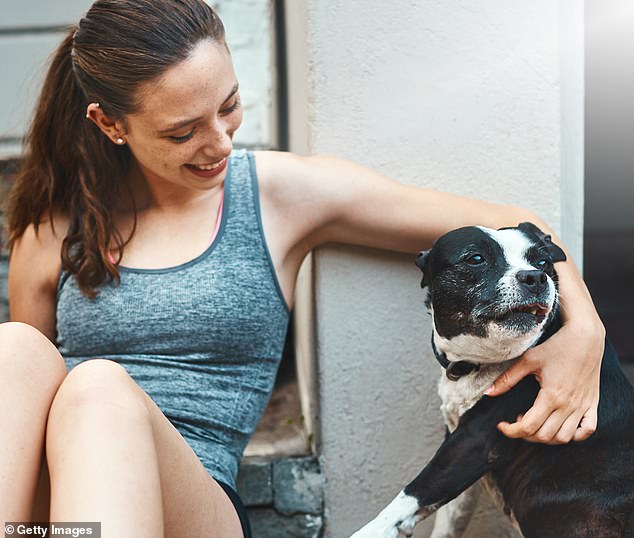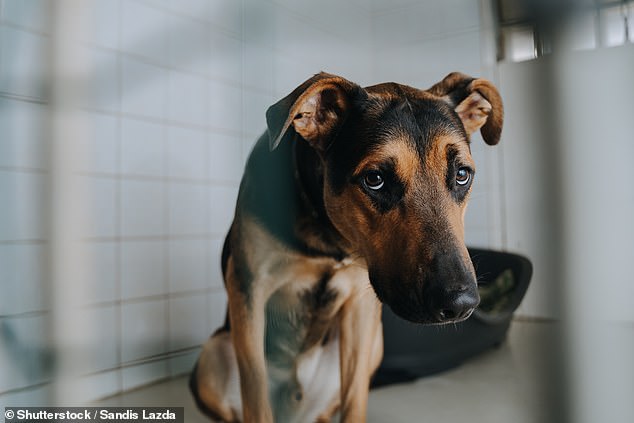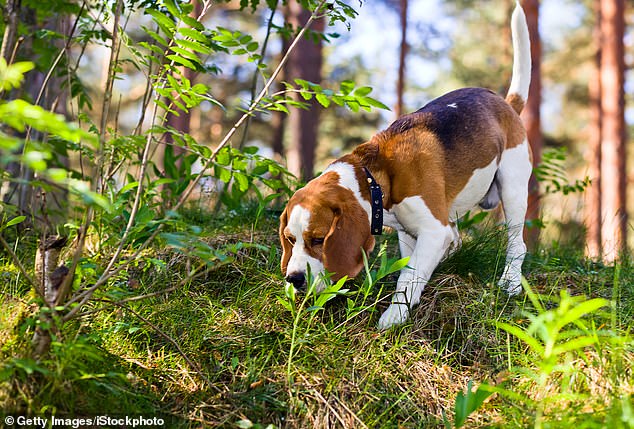I am an animal expert- here’s what you don’t know about your dog
People often misinterpret dog signals, thinking that a wagging tail or a lick to your face always means your dog is happy.
But these may actually show signs of stress in your canine companion.
Veterinarian and dog expert Dr. Joanne Fernandez-Lopez said her childhood friends described her as “the dog translator” long before she went to vet school.
As director of veterinary affairs at ABCs Puppy Zs, a Texas Goldendoodle breeder, and assistant veterinarian at pet care company Dutch Pet, Inc., Dr. Fernandez-Lopez has more than ten years of experience working with dogs.
She told DailyMail.com that there are ‘hundreds’ of behaviors a dog exhibits that owners regularly misinterpret.
The vet said, “I could literally write a book with hundreds of characters!” But here are just a few.”
Wagging tail
The above shows a dog with its tail in a neutral position, meaning it is not particularly excited or stressed
Anyone who has come home to their dog after a long day has experienced the happy wagging of their tail as they walk through the door, or seen their pup’s carriage shake when the treat jar is opened.
But a wagging tail isn’t always a sign of happiness or excitement, Dr. Fernandez-Lopez told DailyMail.com.
The position, speed and even direction of a dog’s tail is more complex than that.
She said: ‘It seems people think a wagging tail means happiness, but that slow, stiff wag can at best show insecurity, if not potential caution.
‘Also consider the context and the force with which the tail is wagging.’
The faster a tail wags, the more “excited” the dog is, but that can mean both a good and a bad thing. A wag when the tail is straight up indicates a dog that is on high alert or may be in an aggressive state of mind.
A pulled tail means anxiety and stress.
And one study Wagging dog tails showed that the animals tend to wag more to the right during positive arousal and more to the left when negative arousal.
I ignore you

A dog may lean away or ignore a person if they are afraid
The moment when a dog turns its head away from you is easy to misinterpret.
Dr. Fernandez-Lopez said, “A dog that turns its head away or avoids eye contact is not rude.
“This is a calming signal, proving they are not dangerous, but wishing you well rather than breaking up the party.”
When you approach or reach for your dog and he turns his head or leans away from you, it signals that he is stressed, and it may be a good idea to observe the environment to see what has confused him.
A dog may also lean away or ignore a person if they are afraid.
What’s important, experts say, is not to force affection or make contact with a dog showing these symptoms, as this could lead to aggressive behavior.
Yawning and licking lips

Could this be a sign of stress?
Dogs may yawn after a long game of fetch or lick their chops after eating, but they can also do these things when they are stressed.
Dr. Fernandez-Lopez said: ‘A sheepish yawn and lip licking are often confused with drowsiness or hunger and are certainly potential leading indicators of stress or discomfort in their current environment.
“The first is a way for the dog to comfort itself, the second has to do with its discomfort.”
According to VCA Animal Hospitals, a stress yawn usually lasts longer and more intense than a sleepy yawn. Dogs can also drool.
In addition to licking their lips, stressed dogs may also excessively lick their paws or another body part, because licking is a self-soothing action.
Stretch

When your dog stretches he may look relaxed, but there is more to this behavior
If you notice that your pet is a downward dog, it could mean more than just your average stretch. It can actually be a warning sign of stress, Dr. Fernandez-Lopez said.
She added, “While stretching may seem like a common, comfortable behavior, canines also perform it as a calming signal.
“Dogs that respond by stretching may be trying to reduce their anxiety.”
Just like humans, dogs can stretch to relax the tension in their bodies caused by stress.
Excessive stretching with the head down and butt up in the air can also indicate physical pain, including life-threatening health complications. So it is important to go to your vet if you notice that your dog exhibits this behavior a lot.
Lifting a paw

Lifting a paw can mean that a dog is uncomfortable in the current situation
Maybe you’ve taught your dog the command “paw” or “high five,” so when he lifts his paw you think your training was successful.
But a raised paw can actually mean that a dog is scared, stressed or uncomfortable in his current environment.
Dr. Fernandez-Lopez told DailyMail.com: ‘If a dog lifts one of its paws, this will often indicate that they are unsure about something in the environment.
‘Especially if the eyes show an expression of curiosity or concentration.’
Some dog breeds are known for raising their paws while hunting, but outside of this context, a raised paw can indicate that a dog is insecure or feeling unsure about a situation, according to the American Kennel Club (AKC).
Whale eye

If a dog shows the whites of its eyes, it could be a sign of stress
Dogs showing the whites of their eyes, which is known as ‘whale eye’, is a common indicator of stress or excitement.
Dr. Fernandez-Lopez said: ‘If dogs show the whites of their eyes, it could be a sign of stress or that they are uncomfortable.
“It’s a dog version of ‘I’m not feeling okay and I might need some distance.’
The AKC said people may observe this behavior if they touch a shy dog’s head or if someone – or another animal – gets too close to them while eating or chewing on a toy.
Giving the whale eye may indicate that the dog is scared or stressed about having his food or toys taken away.
Lowered head and ears

The positioning of the body, head, ears and tail can reveal a lot about how a dog is feeling
If your dog appears crouched with his head and ears low, he is likely stressed.
Dr. Fernandez-Lopez told DailyMail.com: ‘Although some owners know how to interpret alert ears, ears held back or down can indicate fear, anxiety and submission.’
Ears pulled back indicate that dogs are worried, suspicious or defensive. ‘Seal ears’, when the ears are pinned almost completely back to the head, indicate extreme fear.
A lowered head often means the dog is anxious and may also have a tucked tail or furrowed eyebrows.
Lowering the head or crouching down makes the dog appear smaller, which a nervous animal can do to avoid drawing attention to itself.
A bowed head and crouched posture also make the dog appear submissive to whatever threatens the animal.
The sniffing of the ground

Sniffing can sometimes be an avoidance or displacement behavior
A dog’s sense of smell is up to 100,000 times more powerful than a human’s, and sniffing is your pet’s way of interpreting the world around him. So it’s normal to think that when your dog’s nose is grounded, he’s just curious.
However, Dr. Fernandez-Lopez said this is not always the case: ‘Dogs may sniff the ground if you ask them a question that is too “pushy” or in other situations that make dogs stressed or insecure.
‘It is a method to keep conflicts at bay and reduce tensions.’
According to VCA Animal Hospitals, sniffing can sometimes be an avoidance or displacement behavior, which means that the dog can sniff to ‘escape’ a stressful situation by focusing its attention on something else.
Other displacement behaviors include licking genitals, scratching, shaking, or directing attention to something other than the current situation.
